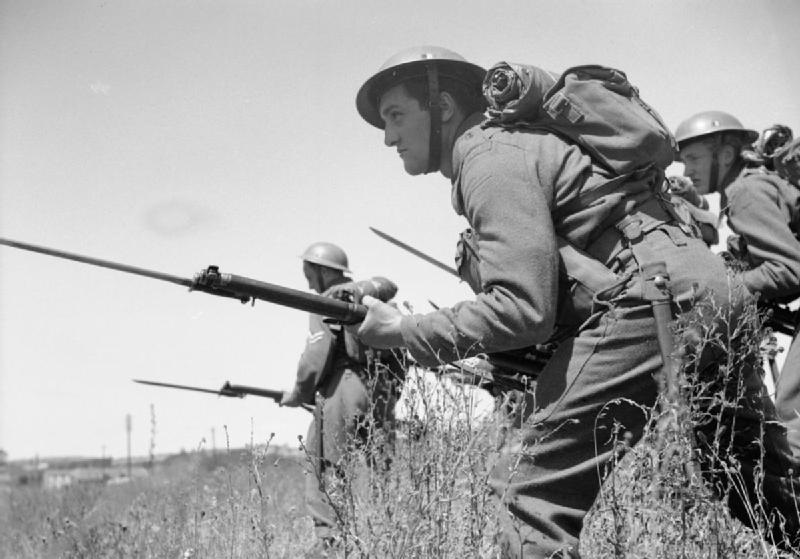The exploits of the Belgian Free Forces in northwest Europe during the Second World War are renowned, not least in the coastal towns of Normandy freed by the Brigade Piron. From Sallenelles to Honfleur, nearly every commune on the Côte Fleurie has a memorial to their liberators.
Next year, the 80th anniversary of the Normandy Landings, a new monument will be unveiled in Auberville to commemorate the 27 Belgians who fell in August 1944.
That the Belgians would even take part in the Allied campaign, finally avenging their defeat four years earlier, was a far from foregone conclusion, however.
A controversial, unpublished memoir by Lieutenant General Baron Charles de Cumont, commander of the 1st Battalion of Belgian Fusiliers in Britain from October 1940 to September 1942, reveals how the embryonic free forces were rocked by rivalries, frustration and mutiny. This was largely covered up at the time and glossed over since in oft-sanitised accounts hailing the brigade’s heroic deeds.
De Cumont’s 14,000-word type-written memoir tells a very different story and makes no attempt to conceal the bitter fights he faced, long before the battalion fired a shot in anger. A tough disciplinarian, he pushed his men hard. Woe betide anyone who fell short of the standards he expected. He is openly critical of senior officers who displayed a lax attitude or, worse in his view, loose morals.
De Cumont must have known his memoir, written after he retired, would cause consternation. Before he died, he ordered his family not to allow its publication until everyone named in it had also passed away.
With all but a tiny handful of World War II veterans still living, Bernadette de Cumont, youngest of his eight children with wife Annette, decided to entrust the memoir to The Brussels Times magazine.
Belgium surrenders
At the outbreak of war in September 1939, de Cumont was deputy military attaché at neutral Belgium’s London embassy, headed by 69-year-old Ambassador Emile de Cartier de Marchienne, dean of the diplomatic corps. De Cumont writes that he was unsurprised when Germany invaded Belgium on May 10, 1940. “No one ever believed in Hitler's good faith,” he says.

Lieutenant General Baron Charles de Cumont
After 18 days of fighting in which Belgium’s outnumbered and ill-equipped forces were pushed back into the north-west corner of the country, King Leopold III ordered the army to surrender – without bothering to consult the government.
De Cumont passes no judgement on the King’s decision, which would divide the country and come back to haunt Leopold. After the war, opponents accused Leopold of collaboration and the so-called ‘Royal Question’ cost him the Crown in 1951.
De Cumont is more critical of Belgium’s ally. “With their backs to the sea, we thought the British would fight as they did at Torres Vedras,” he comments, referring to the Duke of Wellington’s defence of Lisbon in 1810 during the Peninsular War.
Instead, the British Expeditionary Force and remains of the battered French and Belgian armies retreated and were cut off at Dunkirk. Winston Churchill, who had just been named as Britain’s Prime Minister, feared a disaster but Adolf Hitler prevaricated. Vice Admiral Bertram Ramsay launched Operation Dynamo, mobilising an armada of civilian vessels across the Channel. Between May 26 and June 4, the “little ships” rescued more than 338,000 stranded troops.
De Cumont’s friend Maurice Rey was among the Belgian soldiers at Dunkirk, determined to fight on, but they were not a priority for the retreating Brits. “He was turned back by the sentries. No Belgians were allowed to board,” writes de Cumont. “So Rey put on civilian clothes. He was turned away again. So he grabbed a rifle, a British helmet and great-coat, got back in the line and embarked.”
Rey’s great escape was short-lived. After arriving in Britain, the young lieutenant was jailed as a suspected spy.
Other troops converged on De Panne and Dieppe. De Cumont was dispatched from London to Dartmouth to organise a Belgian evacuation. He rounded up a group of Belgian skippers and offered them £1 for each man they brought back. Most thought it was a suicidal mission, but five boats were persuaded to make the crossing. Two grounded in the harbour – “probably on purpose” says de Cumont – but the other three made it. One alone came back with 1,500 men.
End of the world
Belgian General Victor van Strydonck de Burkel, a 63-year-old First World War hero, made his own escape across the Channel via Boulogne. Arriving in London on May 23, he made straight to the Belgian Embassy to meet Emile de Cartier and Minister of Defence Henri Denis, who put him in command of the country’s fledgling force in Britain.
Some who got away joined the Royal Air Force, whose flying aces would include Belgian pilots Raymond Lallemant, Jean Offenberg and Remy Van Lierde. Albert Guérisse, a doctor who won Britain’s George Cross for gallantry, enlisted in the Royal Navy and served behind enemy lines with the Special Operations Executive (SOE) under his nom de guerre, Patrick O’Leary.
However, most of the new arrivals, together with refugees and expatriates eager to do their bit, were sent to a camp at far-off Tenby in south Wales. It felt like the end of the world.

Training in Tenby
A popular hit from the era promised: “We'll keep a welcome in the hillsides, we'll keep a welcome in the vales.” But it didn’t much feel like that for the Belgians. “Our men had no weapons, their clothing was what they carried, and their pay was tuppence a day,” writes de Cumont.
At least they were alive.
In the first days of June, nearly 400 of the men volunteered to return to the continent to fight in Brittany. Within three weeks France had also fallen and only 14 made it back to Wales.
The government-in-exile, then in Bordeaux, ordered all Belgian units in Britain to demobilise. “This was inconceivable for us but … [for the government] our handful of bare feet in Tenby were not worth a serious incident with the Nazis,” says de Cumont.
His superior, Colonel Louis Wouters, warned the ministers that obeying the order would mean internment for Belgium’s troops for the rest of the war – unless they joined General Charles de Gaulle’s Free French Forces. A classic Belgian compromise was reached, with Henri Denis authorising “a voluntary service unit”. “There are times when one should not look at what an order means exactly. We had a piece of paper that allowed us to escape illegality,” writes de Cumont.
Top heavy with officers
A recruitment centre opened in London. Even those rejected by the doctors were allowed to enlist, provided they waived their pension rights. The first recruits included Warrant Officer André Wendelen, who had one kidney but went on to serve with the SOE.
Numbers slowly began to grow at Tenby though de Cumont admits the troop was top heavy with officers, with too many reservists and some too old for active service. Not that this looked like becoming a reality soon.
The Belgians had come to Britain to fight. Instead, they quickly became bored and frustrated. Far from their wives and girlfriends, it was hardly a surprise that some fell prey to temptation. Several officers were soon “causing a scandal” due to their excessive drinking, writes de Cumont. It was a portent of difficulties to come.
However, there were morale-boosting moments, too.
On July 21, 1940, the Belgian free forces held a grand parade in Tenby. They were issued with British battledress and van Strydonck reorganised the detachments. A training group for non-commissioned officers was set up under Lieutenant Jean Bloch, who would be among the first troops to enter liberated Brussels four years later.
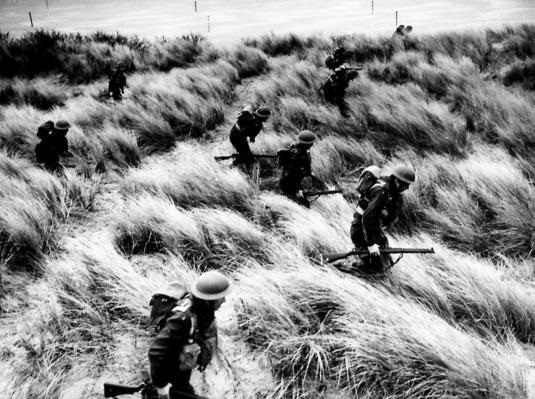
Training in the Welsh dunes
By October, the units became a battalion. Although not his first choice, van Strydonck asked 38-year-old de Cumont to command it. “I did not hesitate,” he writes.
Promoted to Major, de Cumont quickly discovered that the job came with unenviable responsibilities. A few days after his appointment, an officer came to see him, explaining that he did not feel up to the job and wanting to be relieved of his duties. De Cumont tried to persuade him to continue but shortly after, the man committed suicide. De Cumont was shattered. You expect to lose men in battle, but not in a training camp.
He also faced an early challenge to his authority from Captain Louis Legrand, a popular and charismatic officer who, along with many others, had made his way to Wales after a long and perilous journey through France, Spain and Portugal.
Legrand, in charge of the battalion’s 1st Company, was a committed royalist. He persuaded several officers to sign a protest letter after Belgium’s exiled Prime Minister, Hubert Pierlot, gave a speech labelling the King’s surrender as unconstitutional.
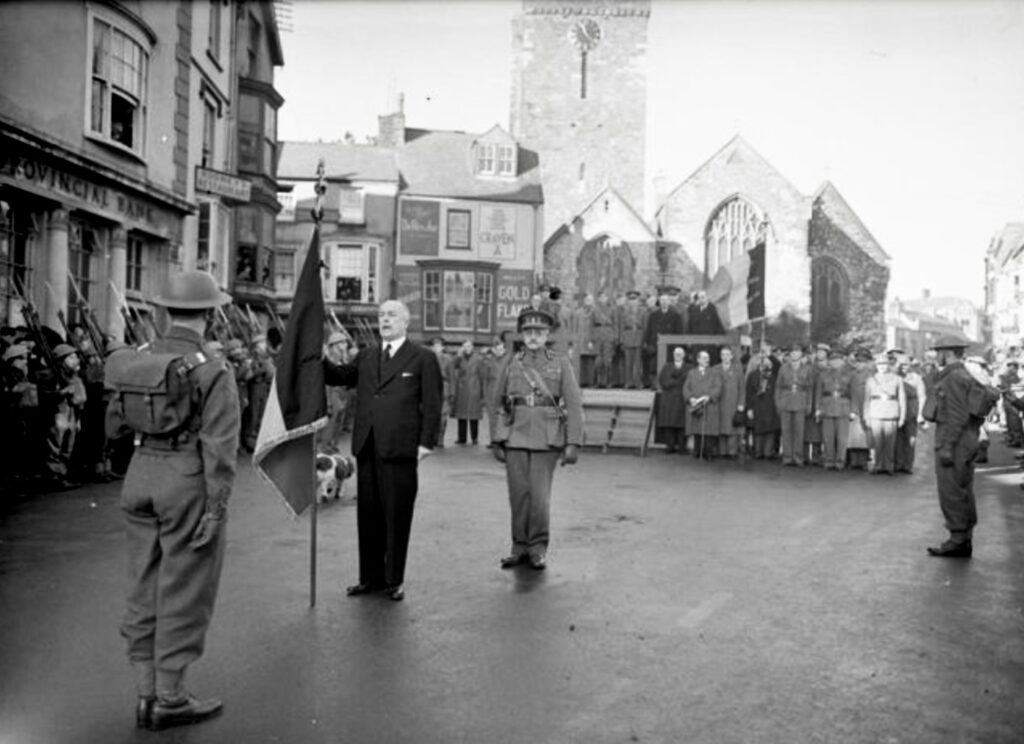
The army presenting its colours to Prime Minister-in-exile Hubert Pierlot
Legrand planned to hand the letter to Pierlot in person. De Cumont discovered what he was planning and ordered him not to confront the PM. Legrand went ahead anyway, engineering a private meeting with the premier. It was never clear if he gave him the letter but when he returned to Tenby, Legrand’s face was “a radiant smile,” after persuading Pierlot to make him chief of staff for national defence.
De Cumont was furious. “It was a serious breach of discipline”, he writes. “It often happens that officers do not share the views of a minister or a government. In peacetime, they have the right to leave, in time of war to fight, and at all times to remain silent. Those who break this rule harm the army, even if they achieve a short-lived success,” he adds.
Legrand later joined a British tank squadron and distinguished himself at the Battle of El Alamein, winning the DSO (Distinguished Service Order). He was killed in Normandy on June 27, 1944 when his tank took a direct hit from an 88mm shell at Mouen, near Caen.
New colours
Meanwhile, back in Wales, the battalion settled into a busy routine, which revolved around training with British units on coastal defence and anti-invasion duties. The 1st Company spent six weeks at Llanelly, attached to the Gloucestershire Regiment, while the 2nd was sent to Cardigan to support the South Wales Borderers.
Weapons were still in short supply. The 3rd Company, with the Independent Infantry Brigade at Haverfordwest, had only 30 rifles between more than 150 men. “The guns were so scarce that…each platoon received only three hours of training a day,” de Cumont recalls. The 4th Company was based at Penally, under Lieutenant Henry Salman. A Dominican priest in civilian life, Salman later became a tank commander in the British Army and received the DSO for fearless leadership.
The battalion reached full strength by the end of the year. On February 15 1941, Prime Minister Pierlot, accompanied by Finance Minister Camille Gutt and Foreign Minister Paul-Henri Spaak, presented the unit with its new colours in Tenby town square. “We were very proud, although with our big flat helmets and big gas masks on our chests, we couldn’t have looked good,” writes de Cumont.
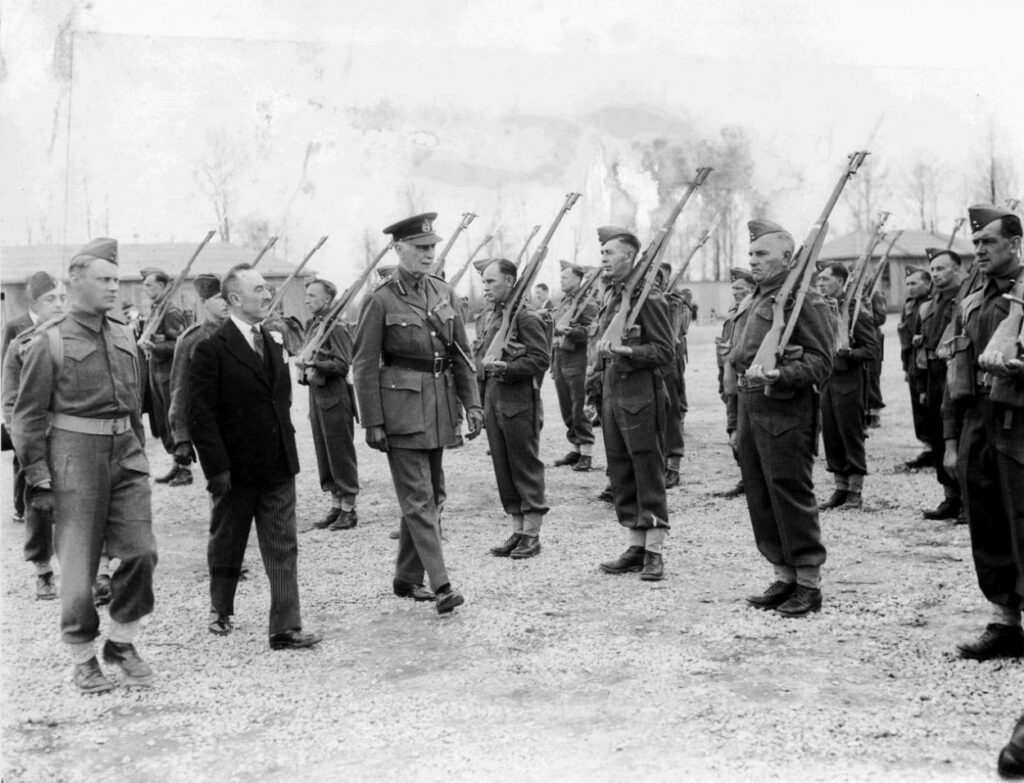
Finance Minister Camille Gutt inspects the troops
Now boasting its own artillery battery and armoured squadron, the battalion moved to Carmarthen, considered a strategic crossroads town in the event of a German invasion. “A diversionary landing was possible there. Our task was to hold the junction until reinforcements arrived,” he says. “We needed to be on constant alert and I enforced regulations to ensure we maintained our discipline. Individual lapses were brutally repressed. To those who told me that these were only exercises, my answer was that stupid mistakes on manoeuvres would be repeated in the first battle. One should not expect fear and fatigue to make men more intelligent.”
European champions
De Cumont insisted the men should work hard – but play hard, too. A mini European football tournament was organised against Dutch, Norwegian and Czech troops. The Belgian team, managed by Private Jacques Wanty, triumphed. But the champions failed to score at a farmers’ dance afterwards. “We tried to chase the Welsh girls but the Italian prisoners of war were more successful,” admits Wanty in his wartime account, Combattre Avec La Brigade Piron.
In June 1941 the battalion moved from Tenby to Great Malvern in England. De Cumont found himself with a new boss, Lieutenant General Raoul Daufresne de la Chevalerie, who succeeded van Strydonck as commander-in-chief. Daufresne’s stock was high after leading the 17th Infantry Division’s brave defence at the Terneuzen Canal during the ill-fated May campaign. He was also known for his sporting prowess. An equestrian and former professional footballer with Cercle and Club Brugge, he coached the national team to gold at the 1920 Antwerp Olympics and represented Belgium in the hockey, winning bronze, and tennis at the Games.
“He was slim and elegant and spoke fluent Flemish and English. The government liked him,” says de Cumont. However, some of the younger officers felt that putting a general in command of 800 men – a job normally carried out by a lieutenant colonel – was not a good look.
August saw the battalion on the move again, back to Wales, to Glanusk Park near Brecon. De Cumont was happy with their progress. “The men were in good spirits and, despite their rather high average age, felt capable of campaigning. There was a certain amount of impatience, however, and a fear of not seeing action,” he writes.
King’s marriage
It was at Glanusk that he first learned of King Leopold’s controversial marriage to Lilian Baels, daughter of a former governor of West Flanders. The King had been a widower since losing his first wife, the popular Queen Astrid, in a car accident six years earlier. De Cumont assembled the battalion in the courtyard of Glanusk Castle to announce the nuptials. The proclamation met a cool response. Many felt the monarch should have waited until the war was over. “I was told later that some portraits of the King had been torn up,” he says.
In December 1940, the battalion was posted to the English cathedral city of Hereford, 25km east of the border with Wales. The boys were delighted: 3,000 young women were based there with the ATS (Auxiliary Territorial Service, the women’s branch of the Army), WAAF (Women's Auxiliary Air Force), and WRENS (Women's Royal Naval Service).
De Cumont, however, was troubled by some of the new officers joining the battalion. The first, described in the memoir only by his initials, “D.N.”, turned up at the camp with his mistress and immediately asked to go on leave. De Cumont quickly dispensed with his services.
He was followed by Captain Paul-Louis Nowé, a First World War veteran who had arrived in Britain after being held at the infamous Miranda de Ebro concentration camp in Spain. De Cumont felt that Nowé, who would later serve with distinction in Normandy, was too “political” and “fond of plotting”.
A third new recruit was Capitaine-Commandant Alfred Ittner, a 45-year-old gunner, whom De Cumont describes as “the worst officer I ever had under my command”. He claims that Ittner had been sent back in disgrace from the Congo “for having compromised the dignity of an officer” with local women. De Cumont raged when he caught him drinking during an exercise.
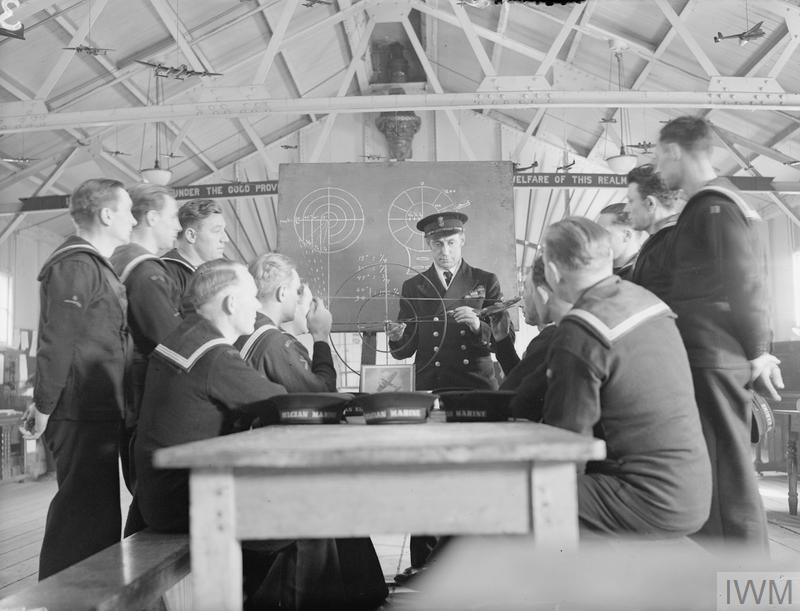
Naval officer training
Another new officer, a diplomat identified as “C”, was also an embarrassment. When one of the men lit a fuse to destroy two grenades that had failed to go off during an exercise, “C” leapt up and ran away in front of everyone. “The whole Company burst into laughter,” recalls de Cumont.
But De Cumont had seen enough. He sent a confidential note to Daufresne, naming C and five other officers who were, in his words, “not suitable for the battalion”. Unfortunately, the note was copied and seen by the officers concerned. It did not augur well.
A second battalion was created under Major Pierre Grisar, despite de Cumont’s strong misgivings. “An elderly man, disillusioned, worn out by life, smoking 60 cigarettes a day, he was courting one of the two young girls…while remaining faithful to a mistress in Belgium.”
Piron arrives
De Cumont, meanwhile, was feeling increasingly isolated. In his memoir, he talks of a sense he was constantly being spied on by disgruntled officers amid “a maze of intrigues”.
It wasn’t only the officers who were starting to rebel. A visit by Camille Gutt on January 2, 1942 went down badly with the lower ranks, especially when the Minister called for better discipline. “The men drowned out his words with incessant and artificial coughs. Gutt was disgusted. It was a set-up,” says de Cumont.
Four days later, Major Jean-Baptiste Piron landed in Greenock, Scotland, accompanied by Major Frédéric de Selliers de Moranville and Lieutenant René Didisheim after escaping through Spain to Gibraltar. All three – Piron especially – would play a pivotal role in the future of the Belgian forces.
As a career officer, having served in both the army and air force during the First World War, 45-year-old Piron expected a senior role and Daufresne put him in command of a new combat group.
De Cumont was not a fan. His memoir suggests Piron was antisemitic, anti-Catholic, a womaniser and very impolite. However, Piron was tall – seen as an asset for an officer – and handsome, with the look of a warrior with experience.
De Cumont’s battalion moved back to Carmarthen, acquiring more “lamentable” recruits. He singles out the 40-year-old son of a wealthy Belgian industrialist in Egypt for particular ire. He was “spoiled, soft, rotten with money...he didn't stay long but did a lot of damage,” de Cumont writes.
A platoon leader in the 1st Company, meanwhile, was cavorting with an English horsewoman, presumably married to someone else, though the memoir doesn’t clarify this. De Cumont blamed Ittner for failing to rein him in and sent a report to Daufresne accusing Ittner of “a total lack of morality and responsibility”. Another officer “did detestable service” and de Cumont admits he punished him “with severity”.
His mood was probably not helped by the loss of his wife Annette, who had been a great support in the battalion hospital where she was “adored”. Due to a lack of suitable accommodation, she had returned to their home in Surrey, 200 km away, after giving birth to their fifth child, Marie Victoire.
Dinner debacle
Meanwhile, de Cumont’s tense relationship with Piron blew up at a dinner hosted by Freddy Gréban de Saint Germain, commander of the 2nd Company. Gréban seated Piron on his left and de Cumont on his right. As the senior officer present, Piron felt he should have been on the right. “He believed that it was a calculated insult and never forgave Gréban, nor me, whom he believed to be an accomplice.”
At the end of June, de Cumont received orders for the 1st Battalion to move to Walton Hall in Warwickshire, while Daufresne established his HQ in nearby Leamington Spa. De Cumont admits his battalion was “bored to death” in their new base (although their mood was briefly eased by an encounter with the glamorous Rachel Verney, Lady Willoughby de Broke, who became a pin-up for the Belgian forces). It didn’t help that they had a large new RAF airfield on their doorstep. “All the girls and all the pubs around were taken by the RAF. There was no more drinking or flirting. A soldier, far from his family, deprived of this and not supported by a hope to fight, is soon ripe for despair,” he writes.
Daufresne, meanwhile, became the focus of gossip among the men. He was apparently making regular nightly trips to meet a mistress and had been spotted canoodling with the said redhead – in the chaplain’s car of all places.
De Cumont decided to have a quiet word with the General to put him in the picture. “He was charming, thanked me for my frankness, swearing he had only seen the woman twice. He shook my hand effusively and I returned to my battalion, disgusted and without illusions.”
Daufresne also managed to blot his copybook with the Belgian government. During a dinner with media present he was overheard attacking Camille Huysmans, the socialist mayor of Antwerp, who fled to London after the German invasion. Daufresne allegedly said Huysmans – who would become Belgium’s Prime Minister after the war – “should have been hanged” for abandoning the city. When his comment was exposed, he tried to blame another guest. Daufresne had squandered the men’s respect. He was later relieved of his duties and succeeded by Colonel François Lecomte, a 51-year-old artillery officer who had arrived from the Congo.
Mutiny
Amid an increasingly febrile atmosphere, a corporal was court martialled for a minor infraction. De Cumont was not involved but the case enraged the NCO’s comrades. The 3rd Company responded by refusing point-blank to drill in the rain.
“Everything was tried, but the men remained in the barracks,” De Cumont wrote. “I had their part of the camp surrounded by the 1st Company with orders to fire if the mutiny took on a serious aspect. I entered their huts alone and spoke to the men one by one, looking for the cause. We hit a wall. They were united and stubborn.”
De Cumont replaced the 3rd Company commander, but the damage was done. In July, a new multinational commando unit was set up, with Belgian, French, Dutch, Norwegian, Danish, Polish and Yugoslav recruits. De Cumont lost six officers and 60 men in what he called “an irreplaceable bloodletting”. The 2nd battalion was dissolved, and the 1st Battalion was sent back to Wales, teaming up with the British 49th Division, at Penybont.
The intensive training continued. A successful night exercise with the Royal Marines was marred when de Cumont spotted a cigarette light. A big no-no. It was the chaplain. De Cumont ordered him to put it out. Recognising the major’s voice, a former legionnaire snapped: “He's here again, this animal,” earning himself eight days in the lock-up.
The next flashpoint was a church parade. Everyone should have been spick and span but the 2nd Company turned up with unpolished shoes. Gréban, their commanding officer, was furious and ordered punishment drill. The men refused to obey and de Cumont had to intervene again. News of this latest outbreak of mutinous behaviour was bound to reach HQ and an inquiry was launched.
Pushed out
De Cumont was then called to London to discuss a reorganisation. “When I wanted to speak, Piron, although not the chair, cut me off. My case was fought over for three days. Then my transfer to HQ was announced, without assignment.”
Betraying no hint of the emotion he must have felt, de Cumont adds: “Major Piron took over the battalion.”
He found the situation at HQ no less volatile. The battery troop refused to salute officers for three days. But worse was to come. A captain slapped Colonel Lecomte – “and then went out and told everyone…they almost fought a duel.”
Discipline had completely broken down. De Cumont was redeployed to be chief instructor at the Western Command School. Piron, meanwhile, was promoted to head the new 1st Belgian Brigade, which would take his name. De Cumont’s old battalion was expanded into three independent units, which spent the next 20 months training in earnest for D-Day.
To their immense disappointment, the Belgians did not take part in the Normandy landings on June 6, 1944, only embarking for Courseulles-sur-Mer and Arromanches-les-Bains two months later when the Allied breakout had stalled. Their late arrival was a blessing in disguise. Despite taking losses during their advance to Honfleur, the casualties were nowhere near as heavy as they might have been.
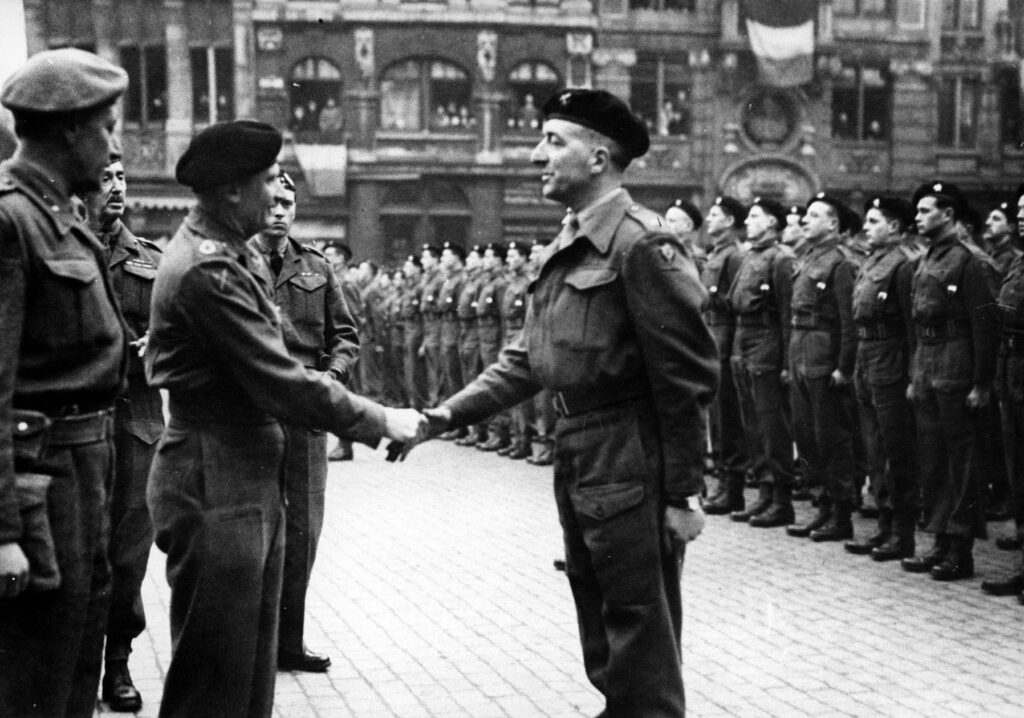
British Field Marshal Bernard Montgomery meets the Belgian army in the Grand Place of a liberated Brussels
On September 4, 1944, after a rapid push from Le Havre, the Piron Brigade took part in the liberation of Brussels after a breakthrough by the Welsh and Grenadier Guards. The Belgian troops were welcomed home amid scenes of wild rejoicing. It was their finest hour.
Frustrated at missing out, de Cumont pleaded with Field Marshal Bernard Montgomery for a fighting command in the British Army. Monty turned him down flat. “I have enough bloody foreigners,” he grunted.
Making the Brigade Piron
Despite his glittering post-war career, de Cumont’s role in the rebirth of the Belgian forces after the surrender in 1940 was largely air-brushed from history. But he commanded huge respect at the time.
For 72-year-old Bernadette de Cumont, the occasionally harsh tone of her father’s memoir is somewhat at odds with her own memories of him. “Every time I read about my father, I discover a little more about what he has done and about his strong character and personality. But as a girl, I remember him as a gentle man and a very human person,” she says.
* Tenby hosted a memorial weekend in September to celebrate its links with the Belgian Free Forces. A Belgian Corner was inaugurated at the local museum and a commemorative plaque unveiled in the town square. The Belgian delegation, led by Lieutenant-Colonel Baron Christian Houtart, chair of the Tenby Memorial Committee, included relatives of the original unit (including two of Charles de Cumont's grandchildren, Carlos de Cumont and Serge de Radzitzky d'Ostrowick) and members of military associations such as Les Amis de la Brigade Piron.
Parallel post-war careers
De Cumont’s career ran in parallel with Piron’s after the war. Both rose to the rank of Lieutenant General.
Returning to Brussels after the liberation, de Cumont joined the Belgian Military Mission and was director of studies at the Royal Military College from 1947 to 1948. He briefly returned to London to serve as deputy military attaché before taking command of the 1st Artillery Regiment in 1950. After a spell in the General Staff, he was appointed Major General in 1955 and commanded I Corps artillery in allied-occupied Germany.
He was Chief of Staff Allied Forces Central Europe at Fontainebleau from 1957 to 1959 and held the same role with the Belgian Armed Forces from 1959 to 1963, when he was made a baron. He chaired NATO’s Military Committee twice, from 1962-1963 and from 1964 until he retired in October 1968. He was received by US President Lyndon B Johnson at the White House at the start of his second term. De Cumont passed away, aged 88, in June 1990.
Piron was aide-de-camp to Leopold’s brother Charles, Prince Regent during a judicial inquiry into the Royal Question. He commanded the Belgian Army in Germany but had a difficult relationship with Minister of Defence Eugène De Greef and was recalled in 1951, becoming an advisor to King Baudouin following Leopold’s abdication. Piron retired in 1957 and died from a heart attack after attending a parade on the 30th anniversary of Brussels’ liberation in 1974. He was 78. The Brigade Piron is commemorated at the national monument which bears its name in Parc des Muses, Molenbeek.

